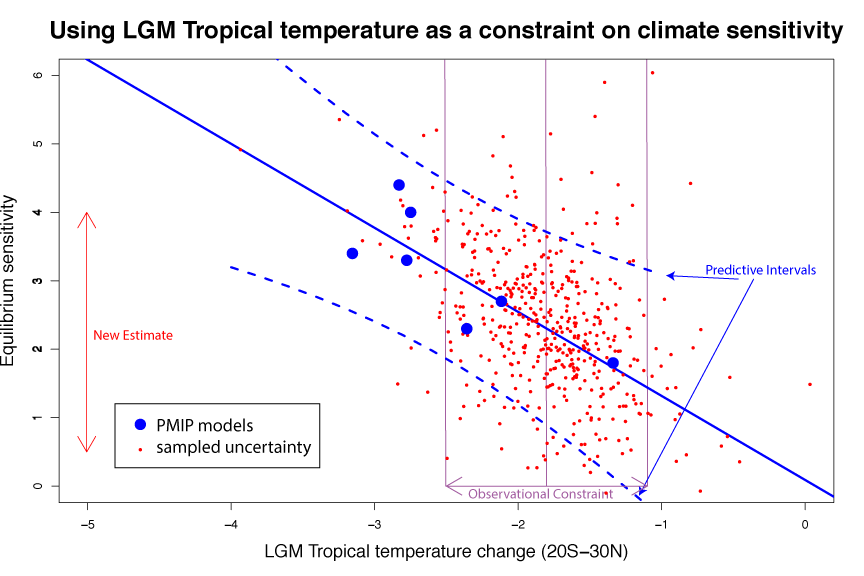Table of Contents
Contact — Julia Hargreaves 2013/04/26 06:53 to contribute to this page, or leave a comment in the discussion box.
Introduction
Climate models combine our understanding of different components the climate, gained largely from observation of processes in the modern climate. The models, designed and tuned to some extent to look like the modern climate, are then used to estimate future climate changes such as those caused by anthropogenic emission of greenhouse gases. The multi-model ensemble of these models gives some sort of estimate of our uncertainty about future climate. It remains possible, however, that this estimate may be further refined by increasing understanding about the way the climate reacts to particular forcings.
The climate history of the earth includes a wide range of different climates, and climate variability on a wide range of time scales. Using this information from the past to learn more about the climate and thus further improve climate models is one of the goals of PMIP. In the Past to Future working group we focus directly on the ways that we may combine information from the past with the multi-model climate ensembles, to provide improved forecasts for future climate change.
The basic idea is that, if relationships exist between past and future climates in model ensembles, then data from the past may be used to inform and even improve the ensemble projections of future climate. This idea may be implemented with various degrees of statistical formalism, and overall the development of quantitative methods taking advantage of experiment ensembles (however small) are still in its early stages, and this is what this page is about.
The method most commonly used to date consists of finding a linear relationship between past and future climates in the ensemble and then using information derived from proxy data from past climate to constrain the ensemble. The figure shown below indicates this procedure for LGM tropical temperature change and climate sensitivity (based on Hargreaves et al GRL 2012). A significant correlation is found in the ensemble between these two variables. The uncertainty in the correlation and in the observational constraint are sampled by the red dots, from which a distribution for climate sensitivity can be derived (red arrows). In principle, however, the relationship between past and future climate may not be linear or so simple. It may indeed be a temporal or spatial pattern of climate change, in which case alternative methods are required. Bayesian methods may equally well be applied; a prior belief for climate sensitivity is updated by a likelihood function in which the models are weighted according to how well they agree with the observational constraint. One important challenge is to identify and quantify the different sources of uncertainties in this process.
We hope this page will evolve in future. Initially, rather than being prescriptive about methods, we focus on providing a list of references. With each we provide a short description, or quote from the paper, which highlights the relevance of the work to Past to Future. We include some work which focusses on recent changes, as the methods are fundamentally the same (for recent observations, the data quality is generally higher, but the signal to noise ratio may be low).
Keywords
To aid comprehension of the following overview we have defined a number of ‘keywords’ that characterise current research on P2F.
- Ensemble : refers to an article focused to the analysis of a series of experiments. The current literature sometimes ensembles of opportunity, that is, a series of experiments that have not been designed with the idea of being analysed as en ensemble, as opposed to ensemble of experiments designed with a carefully chosen sampling scheme (latin hypercube etc. )
- Single-model ensemble, Multi-model ensemble : article making explicit use of one (for single-model) or several structurally distinct (for multi-model) climate models (as opposed to one model with various parameter configurations)
- Bayesian : refers to an article featuring an inference process based on the Bayesian paradigm, with explicit references to a prior, a likelihood and a posterior
- Evaluation : a fairly broad concept referring to the use of model performance indicators, either presented as quantitative metrics, or yes/no pass tests, the main idea being that models which compare well with data for past climates may be more reliable for predicting future climate change.
- Emulator : statistical technique consisting in calibrating a statistical model (generally a Gaussian process) for use as as surrogate to an actual climate simulator (more commonly known as “a climate model”), in order to sample efficiently large input spaces, generally in the context of Bayesian inference or global sensitivity analysis
- Climate sensitivity : papers with attempting to contribute to the quantification off climate sensitivity defined as change in the global average of surface air temperature in response to a doubling in CO2 concentration for pre-industrial.
- Review / prospective : explicit enough.
- LGM, mid-Holocene, Eocene, Past Millennia, Arctic, past century, modern : epoch tags
- Europe, Global, Northern Hemisphere, Southern Hemisphere : regional tags
- Ocean, Atmosphere, Sea-ice, Monsoon, … : climate process tag
- CMIP, PMIP : Project tag
- Detection - attribution : in the climate literature refers to the process of identifying and quantifying forcing agents based on an analysis of the spatio-temporal evolution of both model outputs and observations. A statistical model is generally explicitly defined.
Authors
Contributors to this page:
James Annan, Michel Crucifix, Julia Hargreaves.
[ PMIP3 Wiki Home ] - [ Help! ] - [ Wiki syntax ]
